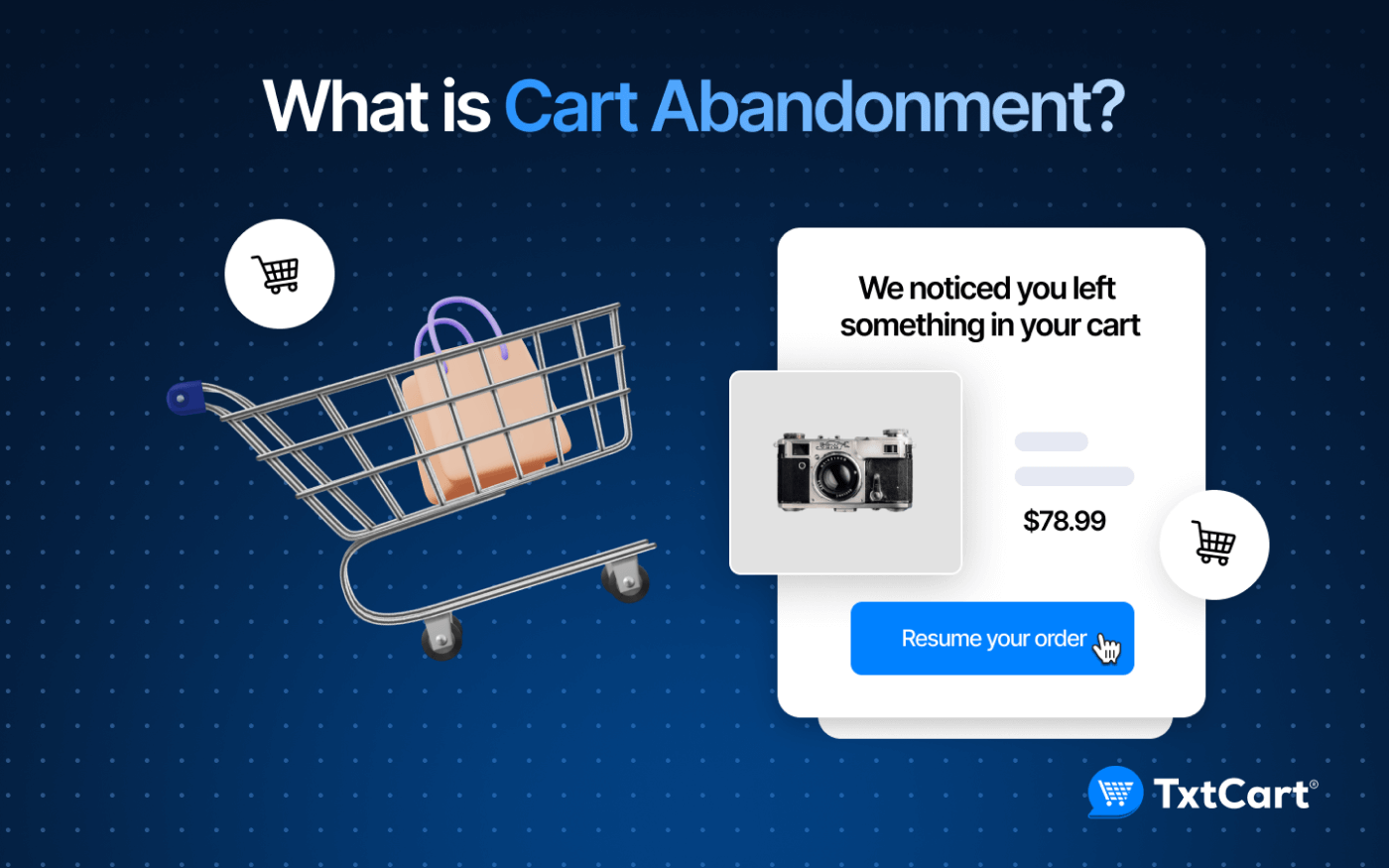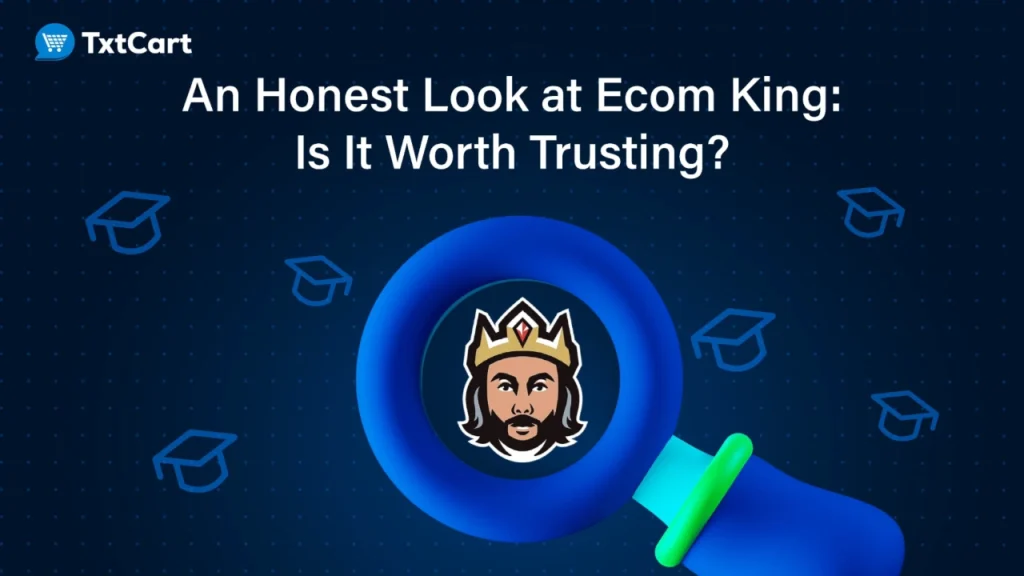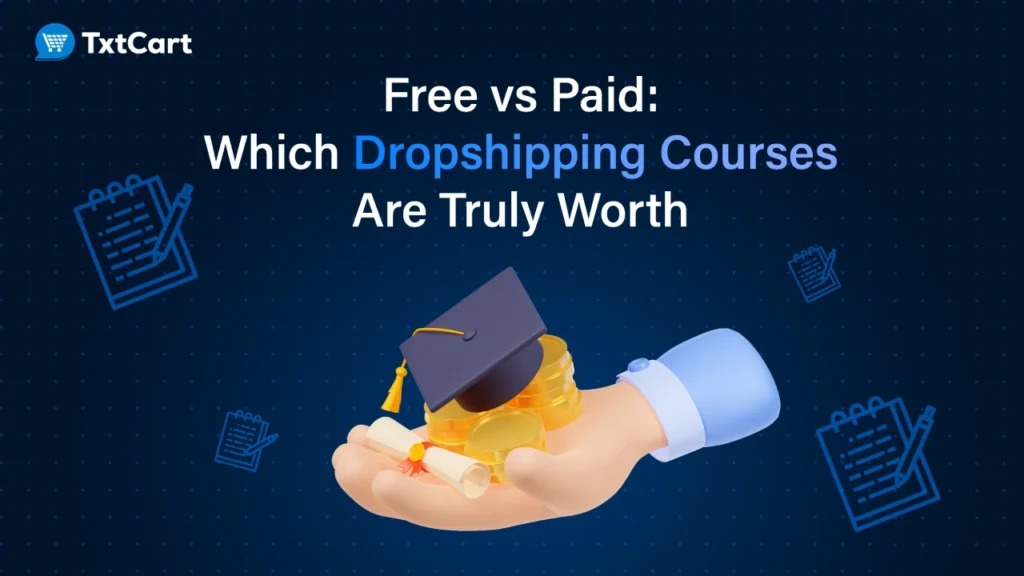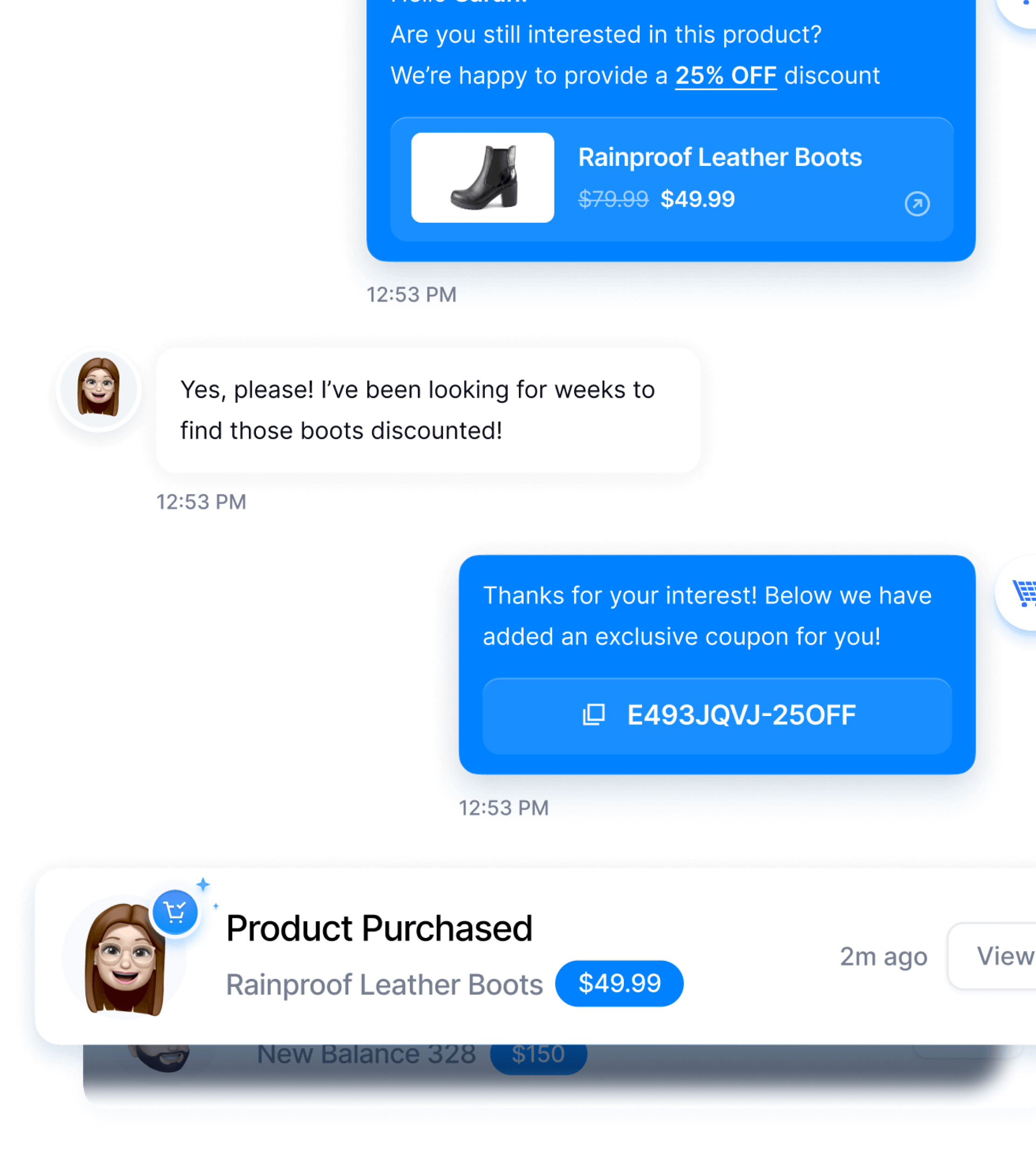Nearly 70% of online shopping carts are abandoned.
Seventy percent. Imagine the revenue left on the table.
This guide breaks down the what, why, and how of shopping cart abandonment. We’ll explore the latest stats, the psychology behind abandoned carts, and effective recovery strategies—including how SMS can be a game-changer.
Here’s what we’ll cover:
- What shopping cart abandonment really means in 2025.
- The psychology behind why people abandon carts.
- The most common reasons for abandonment (and how to fix them).
- Proven recovery strategies, including the power of SMS.
- How to measure your success and boost your ROI.
Ready? Let’s go.
TL;DR – The No-Fluff Guide to Cart Recovery
- Cart Abandonment 101: 70% of shoppers bounce before buying. That’s not just a stat – it’s a gold mine of recovery opportunities waiting to happen.
- Why They Bail: The big mood killers? Surprise costs, checkout mazes, forced signups, and security doubts. Fix these deal-breakers first.
- Recovery Arsenal: From classic email follow-ups to exit popups, you’ve got options. But here’s the kicker – SMS crushes them all with a wild 98% open rate.
- Timing is Everything: Hit them at the sweet spots:
- 30 minutes (while they’re still warm)
- 24 hours (after they sleep on it)
- 72 hours (last chance + best offer)
- Track & Attack: TxtCart’s analytics show you exactly which products get ghosted and why. Use these patterns to fine-tune everything from pricing to messaging.
- Smart Adjustments: Use the data to tweak prices, bundle offers, and time your messages. Because what worked yesterday might not work tomorrow.
- AI Conversations: Skip the robotic and generic cart reminders. TxtCart’s conversational AI handles customer chats by sending eerily human-like cart recovery offers, turning abandoned carts into actual sales while you sleep.
What is Cart Abandonment?
Cart abandonment happens when online shoppers add products but exit before completing a purchase. Any item that enters the shopping cart but never makes it through the transaction is considered ‘abandoned’. While this affects 7 out of 10 online carts, smart retailers can spot warning signs and recover these lost sales.
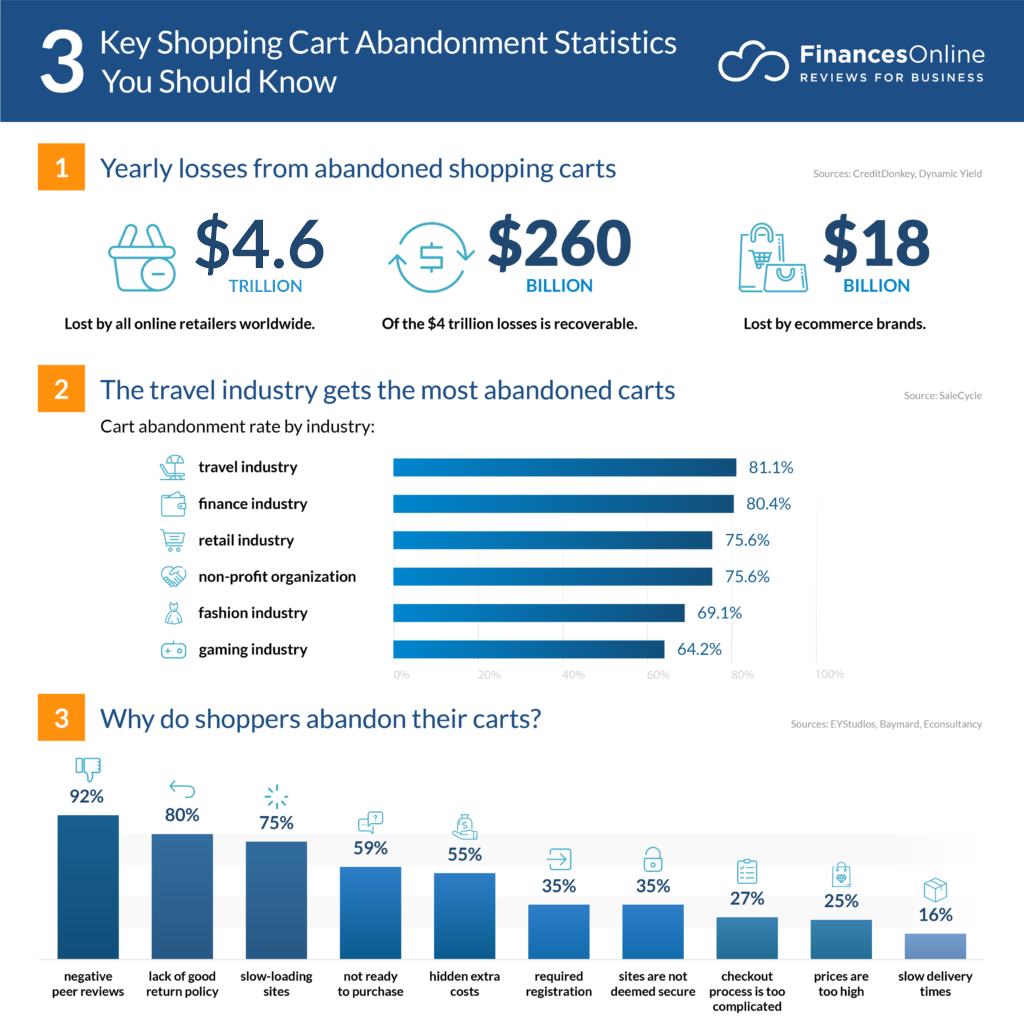
Why Customers Abandon Carts
There are a few key reasons, and we can broadly categorize them into primary and secondary factors.
Primary Reasons (The Deal Breakers)
These are the big ones—the issues that immediately cause customers to bail. They’re often related to practical concerns or friction in the buying process.
- Unexpected Costs: This is the number one reason for cart abandonment. Nobody likes surprises at the checkout page. Hidden fees, high shipping costs, unexpected taxes—these are all major turnoffs. Be transparent about costs from the start.
- Complex Checkout Process: A long, complicated checkout process is a recipe for abandonment. Too many steps, confusing forms, and unnecessary information requests create friction and frustrate customers. Keep it simple. Make it fast.
- Forced Account Creation: Forcing customers to create an account before purchasing is a huge barrier. Many online shoppers just want to make a quick purchase without the hassle. Offer a guest checkout option. It’s a simple change that can make a big difference.
- Security Concerns: If your site doesn’t look secure, customers won’t feel comfortable sharing their payment information. Display trust badges, use HTTPS, and ensure your site is PCI compliant. It’s about building confidence.
- Limited Payment Options: Not offering customers their preferred payment method can lead to abandonment. Offer various options, including major credit cards, PayPal, and other popular digital wallets. Give them choices.
Secondary Factors (The Subtle Nudges)
These factors might not immediately cause abandonment, but they can contribute to a negative experience and make customers more likely to leave.
- Website Performance: A slow-loading online store is frustrating. Customers expect pages to load quickly. If your site is slow, they’ll bounce. Optimize your site’s speed for a better user experience.
- Mobile Optimization: With so many people window shopping online on their phones, a mobile-unfriendly website is a disaster. Ensure your ecommerce store is responsive and provides a seamless mobile experience.
- Return Policy Clarity: A clear and easy-to-find return policy builds trust and reduces purchase anxiety. Make your return policy visible and easy to understand.
- Stock Availability: Discovering an item is out of stock after adding it to the cart is incredibly frustrating. Keep your inventory information up-to-date and clearly display stock levels.
Addressing these primary and secondary factors is crucial for reducing shopping cart abandonment rate and boosting conversion rate. It’s about creating a smooth, trustworthy, and enjoyable shopping experience.
Here’s an interesting graph by the Baymard Institute that also reveals the most common reasons for abandonment during checkout.
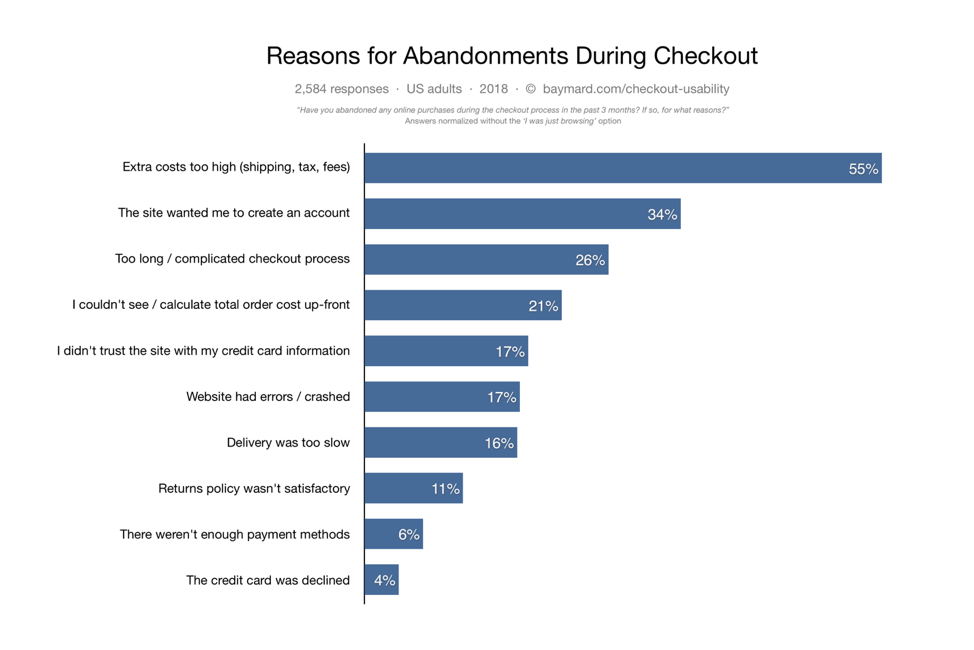
Read Next:
- Text Marketing Statistics You Should Know in 2025
- 8 Hacks to Increase Your Ecommerce Sales Today (Easily)
Reducing Shopping Cart Abandonment
So, customers are abandoning carts. It happens. But the good news is, you can win many of them back. There are several recovery strategies you can use, from traditional methods to more modern approaches. Let’s explore some of the most effective ones:
| Recovery Method | Best Practices | Key Timing | Pro Tips |
|---|---|---|---|
| Email Follow-ups | • Personalize with customer name • Include abandoned items • Consider offering incentives | • First email: Within 1 hour • Second email: 1-2 days later • Final email: 3-4 days after | Test different subject lines and offers to find what resonates with your audience |
| Retargeting Ads | • Show specific abandoned products • Use eye-catching visuals • Include compelling copy | • Start within 24 hours • Run for 3-7 days • Set frequency caps | Segment audiences based on cart value to adjust ad spend accordingly |
| Push Notifications | • Keep messages concise • Include clear CTAs • Respect user preferences | • Send within 30 minutes • Limit to 2-3 notifications • Space them 24 hours apart | Use urgency without being pushy (e.g., “Your cart is waiting”) |
| Exit-Intent Popups | • Offer immediate value • Keep design simple • Make closing easy | • Trigger on exit intent • Show once per session • Reset after 24 hours | A/B test different offers to find the sweet spot between conversion and margin |
SMS is the BEST channel for cart abandonment recoveries, data shows
While traditional methods like email and retargeting ads are valuable, SMS offers a direct and immediate line to your customer’s phone.
People check their texts constantly. It’s a personal and highly effective way to reach customers.
Let’s look at some stats that show the power of SMS:
- SMS open rates are sky-high, often exceeding 98%. Compare that to email open rates, which typically hover around 20%. That’s a huge difference.
- 90% of text messages are read within three minutes of being received. This immediacy makes SMS ideal for time-sensitive reminders, like cart recovery messages.
Now imagine that paired with an irresistible SMS offer that doesn’t sound like a robot – that’s where TxtCart comes in.
Honestly like a money printer for us…
“Within the first 45 days we’ve been able to add an additional $8,500 in revenue to our bottom line with only a small list of SMS subscribers.”
Gamenetics™
TxtCart Customer on the Shopify Marketplace
TxtCart’s Conversational AI Can Send Human-like Texts to Your Customers
TxtCart takes SMS cart recovery to the next level with artificial intelligence specifically honed to answer customer queries and send cart recovery flows with eerily human-like text messages.
TxtCart doesn’t send generic reminders; it starts dialogue. Here’s a sample:
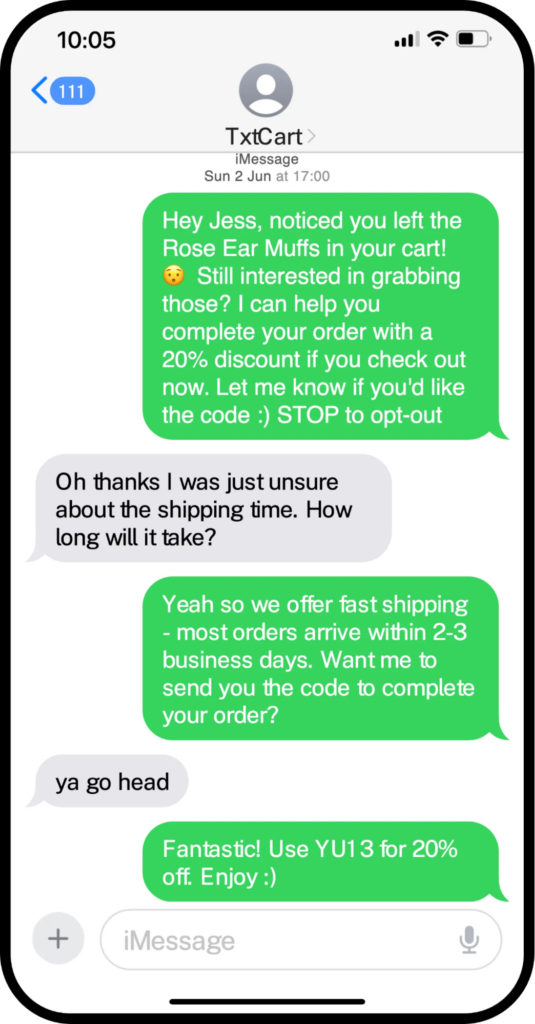
It builds real relationships with your customers on the frontline.
Want to try conversational SMS for free?
Drive more sales with intelligent AI-driven automations that recover carts, engage customers, and streamline flows — saving you 32x in costs. No contracts or minimums.
- Try free for 14 days
- 10x ROI guaranteed
- Join 3000+ Shopify brands
Plus, TxtCart’s smart customer segmentation allows you to send targeted campaigns to users who abandoned their carts with a simple click from a dropdown.
It’s about sending the right message to the right person at the right time.
Joyride, an LA-based dog harness brand, leveraged TxtCart’s 2-way SMS to generate $1,841,617 in revenue, with 23,616 sales generated and over 2.8M customer conversations, driving massive growth in their eCommerce operations.
$1,841,617
SMS Attributed Revenue
12.4x
SMS Attributed ROI
23,616
Sales Generated
“Kyle and the team at TxtCart have been instrumental in our growth. They’ve worked closely with us to create custom solutions and the results have been phenomenal. TxtCart has helped us scale significantly and provided support at every turn.“
Founder, Joyride
Read Next:
- Conversational SMS Guide: 15+ Best Examples, Uses, & Tips
- 50+ SMS Templates for eCommerce That Simply Work
When to send your cart abandonment flows (+ templates)
Send too early, you’re that clingy brand nobody wants. Send too late? You lose the interest and momentum.
We’ve tested hundreds of recovery campaigns and found the sweet spots that hit the perfect balance. Here’s your ready-to-use playbook for cart recovery timing, complete with templates that actually convert if you’re not using TxtCart’s conversational AI:
| Message Type | Strike Time | Cart Recovery Template (if you’re not using TxtCart) |
|---|---|---|
| Initial Message |
Within 30 minutes of abandonment
Why? Cart interest peaks in the first hour. Strike while the product is still dancing in their mind.
|
Quick heads up – those *perfect picks* in your cart are getting lonely! Ready to give them a forever home? 👀
[View Cart]
Pro tip: Check out now to dodge those dreaded ‘out of stock’ notices.
|
| Follow-up Message |
24 hours after initial message
Why? The sweet spot between persistence and patience. They’ve slept on it – now’s your chance.
|
*Psst* – your cart called…
It’s still holding your awesome picks, but it’s getting nervous about other shoppers eyeing them.
[Secure Your Items]
Fun fact: Most of our sold-out items were chilling in someone’s cart first 😉
|
| Final Message |
72 hours after follow-up
Why? The last window before interest drops off a cliff. Time to bring out your best offer.
|
Last call on your cart picks!
Here’s a little *thank you* for catching our eye: **Grab 10% off** when you check out today.
[Save 10% Now]
Bonus: Free shipping on orders over $50 🚀
|
Read Next: The Best Time to Send SMS Marketing Messages
Tracking Your SMS Recovery Efforts
To gauge the effectiveness of your SMS cart recovery campaigns, it’s essential to monitor key performance metrics. We talk about that in this section.
Here’s how to measure your success:
Key Metrics to Track
Txtcart provides a robust set of analytics to help you track your cart recovery performance. Here are some key metrics to focus on:
- Recovery Rate: The percentage of abandoned carts recovered through SMS.
- Open Rate: The percentage of customers who open your SMS messages.
- Click-through Rate (CTR): The percentage of customers who click on a link in your SMS message (e.g., link to their cart).
- Conversion Rate: The percentage of customers who complete a purchase after clicking on a link in your SMS.
- Average Order Value (AOV): The average amount spent by customers who complete a purchase through SMS cart recovery.
- Return on Investment (ROI): This metric looks at the revenue generated from SMS cart recovery compared to the cost of using Txtcart.
Calculating ROI with Txtcart
TxtCart simplifies ROI calculations by providing built-in analytics that track revenue attributed to cart recovery SMS campaigns and all your other SMS-related shenanigans.
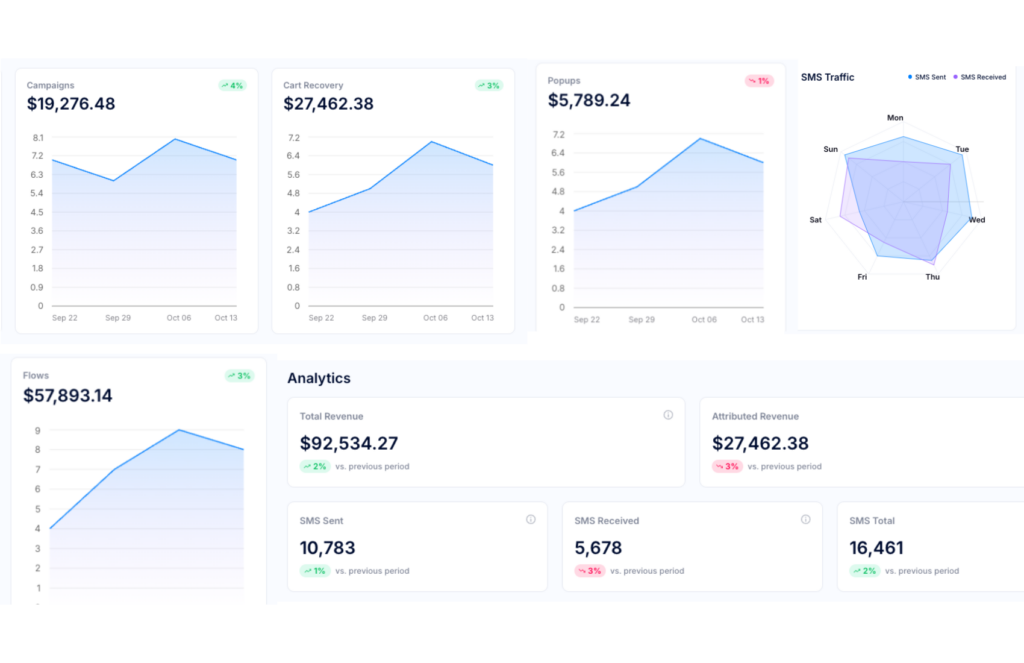
You can also spot which products sail through checkout and which get left behind with TxtCart. These patterns help you fine-tune your recovery tactics and boost your overall conversion rate by:
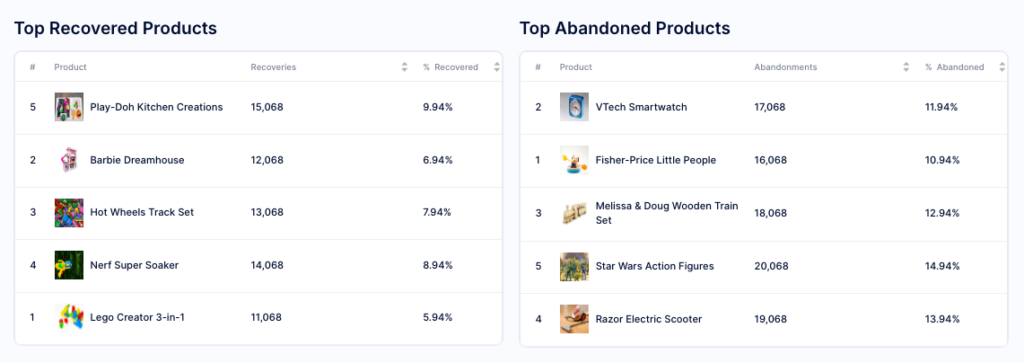
Here’s how to act on those analytics in a practical way:
Price-Point Tweaks
- Test dynamic discounts based on item value
- Offer bundles for frequently-abandoned products
- Adjust shipping thresholds that trigger abandonments
Message Timing
- Speed up recovery emails for high-demand items
- Slow down sequences for consideration-heavy products
- Hit price-sensitive items with strategic weekend offers
Content Adjustments
- Highlight social proof for abandoned premium products
- Showcase “frequently bought together” for complementary items
- Add scarcity alerts for fast-moving inventory
Chaser, an LA-based fashion brand, leveraged TxtCart’s 2-way SMS to generate $207,341 in revenue, with over 10,983 customer conversations and a 42.78% reply rate, resulting in 1,100+ orders generated.
$207,341
SMS Attributed Revenue
10.8x
SMS Attributed ROI
1,100+
Orders Generated

“Kyle and Hunter have been absolutely outstanding to work with and the platform has exceeded expectations. The ROI has been amazing and I’m excited for the future!”
CEO, Chaser Brand
Let TxtCart Take You From Cart Ghosting to Cash Flow
Look, cart abandonment happens. But with 70% of carts sitting empty, there’s serious cash waiting to be claimed. Let’s turn those digital ghosts into dollars.
Here’s what you’ve learned:
- Track the numbers – Know which products get cold feet and why
- Time it right – Hit that sweet 30-min, 24-hour, 72-hour rhythm
- Text to win – Tap into those crazy 98% open rates
- Get smart with AI – Let TxtCart’s industry-leading conversational AI handle your customer conversations and drive sales while you sleep.
- Test and tweak – Because what worked yesterday might not work tomorrow
Toroe Eyewear, a premium performance eyewear brand, used TxtCart’s 2-way SMS to generate $60,382 in revenue, with over 3,400 conversations and a 41.23% reply rate, boosting sales and recovering 800+ orders in 8 months.
$60,382
SMS Attributed Revenue
24.8x
SMS Attributed ROI
800+
Recovered Orders

“Hands down the best SMS Marketing platform we have used thus far. TxtCart allows us to scale our advertising with the profits it generates and has been extremely user-friendly and easy to set up.”
Founder, Toroe Eyewear
Cart Abandonment FAQs
Cart abandonment happens when online shoppers add products but exit before completing a purchase. Any item that enters the shopping cart but never makes it through the transaction is considered ‘abandoned’. While this affects 70% of online carts, smart retailers can spot warning signs and recover these lost sales.
While the average cart abandonment rate hovers around 70%, what’s considered ‘good’ varies significantly by industry and product type. Factors like price point, purchase complexity, and target audience impact acceptable rates. Smart retailers focus on beating their industry benchmark.
Cart recovery strategies deliver substantial ROI, with successful campaigns recovering between 10-30% of abandoned sales. However, effectiveness varies based on timing, approach, and recovery channel. The key lies in choosing the right combination of recovery tactics for your specific audience.
The cart abandonment rate formula is: (1 – completed purchases/initiated checkouts) x 100. While this calculation seems simple, understanding what counts as an ‘initiated checkout’ and tracking partial completions can affect your metrics significantly.
Cart abandonment typically stems from unexpected costs, complex checkouts, and security concerns. While these are the primary factors, various psychological and technical barriers can influence abandonment rates. Understanding your specific abandonment triggers is crucial.
Effective cart recovery combines timely follow-ups, personalized messaging, and strategic incentives. While email remains common, SMS recovery messages achieve 98% open rates. Success depends on choosing the right channels and timing for your audience.
On average, 7 out of 10 shoppers abandon their online shopping carts before completing a purchase. This cart abandonment rate varies by industry and device type, with mobile users showing higher abandonment rates. Several factors influence these statistics.
Read Next:
